Sunday, October 29, 2006
THE CHINESE CEMETERY
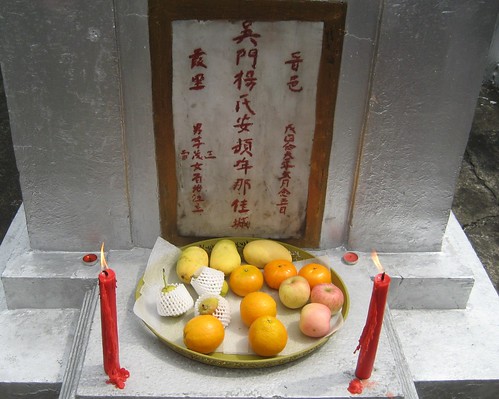 When we were young, spending the weekend in Subic sometimes entailed taking a jeepney to Victory Liner bus terminal in Rizal Avenue in Grace Park. And whenever we’d pass by the Chinese Cemetery, an older cousin would remark that if I were hungry and wanted some free food, all I had to do was go inside this cemetery and feast on the foods left as offerings for the dead by their grieving loved ones. He claimed there were lots of siopao, tikoy, pancit, fried chicken, fruits, and many assorted baked goods to be found inside that cemetery at any time of the week. I was intrigued. I knew well enough that the dead couldn’t possibly consume any of that food, but I wanted to know who really ended up enjoying those delectable offerings.
When we were young, spending the weekend in Subic sometimes entailed taking a jeepney to Victory Liner bus terminal in Rizal Avenue in Grace Park. And whenever we’d pass by the Chinese Cemetery, an older cousin would remark that if I were hungry and wanted some free food, all I had to do was go inside this cemetery and feast on the foods left as offerings for the dead by their grieving loved ones. He claimed there were lots of siopao, tikoy, pancit, fried chicken, fruits, and many assorted baked goods to be found inside that cemetery at any time of the week. I was intrigued. I knew well enough that the dead couldn’t possibly consume any of that food, but I wanted to know who really ended up enjoying those delectable offerings.Interestingly, this image of abundant foods inside the Chinese Cemetery, whether true or mythical, remained etched in my memory that when Ivan advised me of the walking tour he was conducting inside this cemetery this Saturday, I immediately signed up.
And my older cousin was, indeed, right! There were numerous food offerings everywhere, especially now that many people are beginning to visit their respective family gravesite for the upcoming All Soul’s Day. However, when I asked two elderly women, who were sisters, if they would just leave behind their food offering when they leave to go home, I was disappointed to hear a no. They planned, as usual, to give them to their caretakers. As if to erase the puzzled look on my face, one of them quickly added, “No one does that,” she exclaimed, “otherwise, this place would’ve become a breeding ground for all sorts of vermin!” My older cousin, after all, turned out to be only half-right.
 The Chinese Cemetery is part of the three-cemetery complex of Manila; namely: La Loma, North and Chinese. During the nineteenth-century, only the Catholics were allowed to be interred in La Loma. The paupers, non-Christians, victims of communicable diseases, and enemies of the colonial government were relegated to the Chinese Cemetery for burial.
The Chinese Cemetery is part of the three-cemetery complex of Manila; namely: La Loma, North and Chinese. During the nineteenth-century, only the Catholics were allowed to be interred in La Loma. The paupers, non-Christians, victims of communicable diseases, and enemies of the colonial government were relegated to the Chinese Cemetery for burial.Apparently, one of our national heroes, Apolinario Mabini, met three of the aforementioned criteria: he was a Mason; hence, a non-Christian; he suffered from cholera; and his insurgent writings deemed him enemy of the state. And so upon his death on May 13, 1903, he was buried in the Chinese Cemetery; however, his remains were later transferred to his hometown to a permanent gravesite. The pyramid-shaped monument (a significant icon to Masons) now stands on the original site of his resting place at the Chinese Cemetery.
 One cannot just buy a burial plot outright at the Chinese Cemetery; it can only be leased for twenty five years. However, if one had achieved exemplary accomplishments in life — toward the betterment of the community while living, for example — he could be rewarded with a burial site for free as in the mausoleum for Chinese martyrs (above photo). The colorful ribbons signify a recent visit made by family members or friends.
One cannot just buy a burial plot outright at the Chinese Cemetery; it can only be leased for twenty five years. However, if one had achieved exemplary accomplishments in life — toward the betterment of the community while living, for example — he could be rewarded with a burial site for free as in the mausoleum for Chinese martyrs (above photo). The colorful ribbons signify a recent visit made by family members or friends.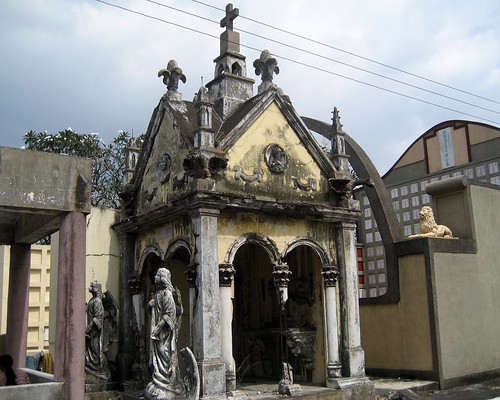 For those families unable to afford a continuance of the lease once due for renewal, they are no longer allowed to do any more maintenance work on their respective grave site or mausoleum. However, the cemetery administrators will not evict the buried by digging up and disposing the remains, because they might only attract bad luck into their life. Instead, a gravesite or mausoleum will be left untouched to decay with time (as in the above photo) until the family itself makes the necessary arrangements to remove and transfer the remains of their loved ones to another tomb somewhere.
For those families unable to afford a continuance of the lease once due for renewal, they are no longer allowed to do any more maintenance work on their respective grave site or mausoleum. However, the cemetery administrators will not evict the buried by digging up and disposing the remains, because they might only attract bad luck into their life. Instead, a gravesite or mausoleum will be left untouched to decay with time (as in the above photo) until the family itself makes the necessary arrangements to remove and transfer the remains of their loved ones to another tomb somewhere.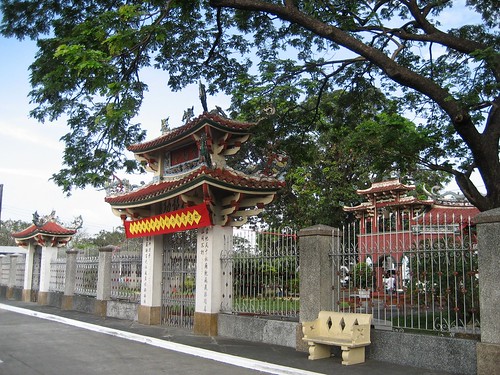 The Chinese Cemetery is only a few minutes from where I live. Having joined this tour, I discovered a nice spot that I can return to whenever I needed a respite from the hustle and bustle of city living — to bring a lounge chair and read a book or just meditate and get lost in space, so to speak. Inside the courtyard of the Chong Hock Tong Temple would be an ideal setting for such activity (above photo). It is supposedly one of the oldest temples in the country.
The Chinese Cemetery is only a few minutes from where I live. Having joined this tour, I discovered a nice spot that I can return to whenever I needed a respite from the hustle and bustle of city living — to bring a lounge chair and read a book or just meditate and get lost in space, so to speak. Inside the courtyard of the Chong Hock Tong Temple would be an ideal setting for such activity (above photo). It is supposedly one of the oldest temples in the country.The Chinese Cemetery boasts some of the most incredible mausoleums in the entire Philippines as in the following photos:
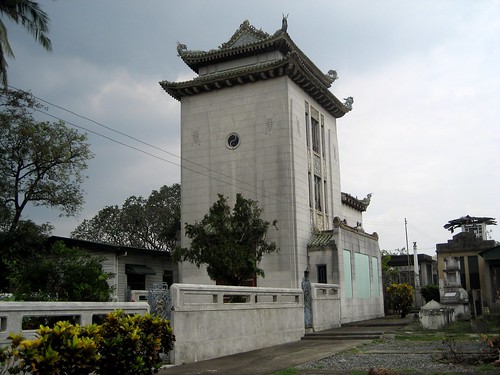 The three-storey mausoleum owned by Dee C. Chuan, son of a lumber magnate and founder of the first Chinese-owned bank in the Philippines, China Bank. Inside hanging against the main wall is the life-size oil painting of Chuan and his wife; rumored to have been done by Amorsolo. A separate cottage beside this mausoleum in the same tract of land is a fully-furnished rest house for family members and guests. It has a living room, bedrooms, bathroom, and just about every necessary feature of a comfortable family dwelling.
The three-storey mausoleum owned by Dee C. Chuan, son of a lumber magnate and founder of the first Chinese-owned bank in the Philippines, China Bank. Inside hanging against the main wall is the life-size oil painting of Chuan and his wife; rumored to have been done by Amorsolo. A separate cottage beside this mausoleum in the same tract of land is a fully-furnished rest house for family members and guests. It has a living room, bedrooms, bathroom, and just about every necessary feature of a comfortable family dwelling.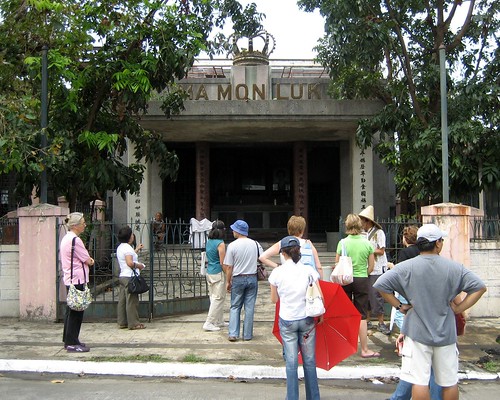 This mausoleum with a huge crown on its top belongs to the king of mami (noodle soup), Ma Mon Luk. His two wives are also buried here on either side of him. Ma Mon Luk was a master salesman, showman, and hopeless romantic; his was a life worthy of a telenovela (soap opera). At least three Ma Mon Luk restaurants I know of are still operational in Binondo, Quiapo and Quezon City near Banawe Street.
This mausoleum with a huge crown on its top belongs to the king of mami (noodle soup), Ma Mon Luk. His two wives are also buried here on either side of him. Ma Mon Luk was a master salesman, showman, and hopeless romantic; his was a life worthy of a telenovela (soap opera). At least three Ma Mon Luk restaurants I know of are still operational in Binondo, Quiapo and Quezon City near Banawe Street.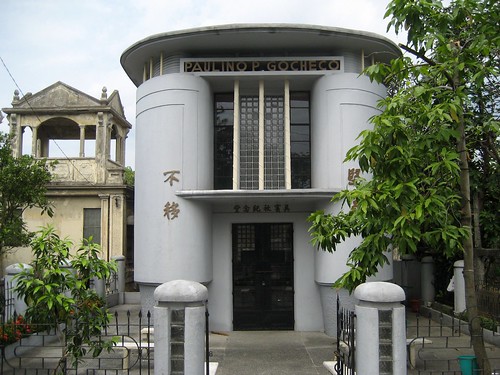 This Art Deco-inspired mausoleum built by the Gochengco Family typifies the American colonial influence even in the architecture of a family resting place. There are larger and even more elaborate ones, though not as well-maintained as this one.
This Art Deco-inspired mausoleum built by the Gochengco Family typifies the American colonial influence even in the architecture of a family resting place. There are larger and even more elaborate ones, though not as well-maintained as this one.As they say, it takes money to build a dream house and so does it take money to maintain it through the years. In this cemetery, a certain Chinese family can further flaunt their wealth through the manner in which their mausoleum is maintained year-round.
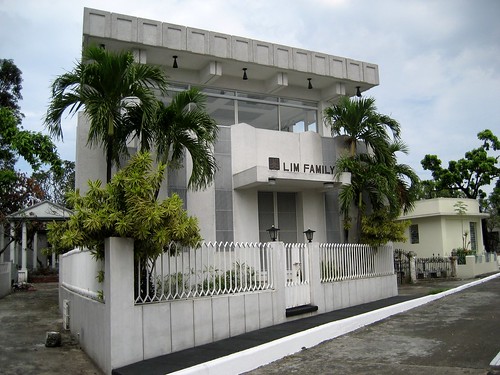 There are also ultra modern mausoleums as this one built by the Lim Family. This reminds me of the contemporary summer houses in the Hamptons in Long Island, New York and in Venice Beach in Los Angeles. Among the mausoleums with modern architecture in the Chinese Cemetery, this one is by far the best designed.
There are also ultra modern mausoleums as this one built by the Lim Family. This reminds me of the contemporary summer houses in the Hamptons in Long Island, New York and in Venice Beach in Los Angeles. Among the mausoleums with modern architecture in the Chinese Cemetery, this one is by far the best designed.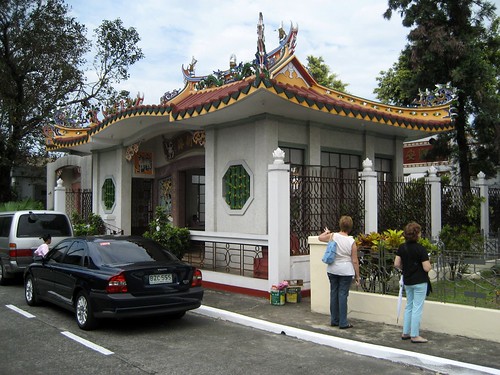 This is, undoubtedly, my personal favorite mausoleum in the entire cemetery. I like it neither because of its whimsical pagoda-inspired architecture nor for the owner’s choice of a European sports sedan. I like it simply because it is the mausoleum with the most bountiful and festive food offering (see photo below).
This is, undoubtedly, my personal favorite mausoleum in the entire cemetery. I like it neither because of its whimsical pagoda-inspired architecture nor for the owner’s choice of a European sports sedan. I like it simply because it is the mausoleum with the most bountiful and festive food offering (see photo below).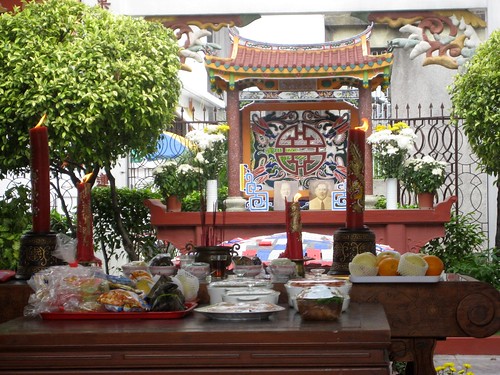 There are far too many interesting gravesites, mausoleums, and monuments in this history-rich Chinese Cemetery that this entry can possibly cover. The stunning interiors of some these mausoleums are also worth featuring extensively. Although a series of blog entries or a dedicated site might do the job, there’s still nothing even more exciting than to actually experience the walking tour itself — to see every point of interest of this so-called city of the dead while Ivan masterfully provides the accompanying history lessons.
There are far too many interesting gravesites, mausoleums, and monuments in this history-rich Chinese Cemetery that this entry can possibly cover. The stunning interiors of some these mausoleums are also worth featuring extensively. Although a series of blog entries or a dedicated site might do the job, there’s still nothing even more exciting than to actually experience the walking tour itself — to see every point of interest of this so-called city of the dead while Ivan masterfully provides the accompanying history lessons. Ivan’s Mounds, Magnates and Mausoleum walking tour this Saturday was for the benefit the Museum Foundation of the Philippines. Besides enjoying the tour, had the pleasure of meeting some fellow members, including its executive director, Tricia Limon.
Ivan’s Mounds, Magnates and Mausoleum walking tour this Saturday was for the benefit the Museum Foundation of the Philippines. Besides enjoying the tour, had the pleasure of meeting some fellow members, including its executive director, Tricia Limon.Ivan's Old Manila Tours
Telephone: 711-3832
Cellphone: 0917-329-1622
Email: oldmanilawalks@gmail.com
posted by Señor Enrique at 11:47 AM
![]()
![]()

23 Comments:
- wysgal said...
I went on Carlos Celdran's cemetery tour a few years back, just in time for Halloween.
A friend from Malaysia who visited Manila a few years back said she found it strange to see a "cemetery tour" on their itinerary, but when they visited the Chinese Cemetery and saw how ostentatious some of the mausoleums were, she realized what all the hullabaloo was about. =)- said...
though my relatives are buried in the north cemetery, i haven't been inside that place. goodie pictures and thanks for sharing.
- PhilippinesPhil said...
Showing off one's wealth, what a passe idea, and how inappropriate in a country filled with so many needy folks. Outrageous... but interesting.
- said...
In Malaysia, we don't have a "cemetery tour" and this is the first time I've heard about it. Looking at the pictures, I can really see how outstanding the mausoleums are.
Well, it's true that usually people do not leave the offerings in the grave. Some do, but most of them will take it home or they'd give it to the caretaker like what the sisters said.
But it sure looks good, the tour!
(:- said...
Interesting how a pariah's cemetery could end up so grandiose. Didn't know that about Mabini... our first Secretary of Foreign Affairs. I like that pyramid thing. Wasn't Rizal a mason too? I wonder where he was originally buried.
- said...
Another interesting post. I also wondered if the food were left at the gravesite. So hindi pala. There are also quite a few Chinese here but I haven't seen anything like this in the cemeteries here. They're probably being practical because the cost of burying someone here is in the $10,000s.
- Senorito<- Ako said...
I knew it was an Ivan tour :). Good blog, good pix as always ! My parents probably went and made offerings already. :)
I would not go there for a read though. It is still a cementery.- Amadeo said...
I sure hope that the government does not have title to the lands on which these cemeteries stand.
In our hometown some years back, the government decided to reclaim the entire complex, both city and Catholic cemeteries, to build a complex of government buildings.
So everybody had to scamper. Dig their loved ones' bones and relocate their "precious" marble lapidas.
Most moved to the then existing memorial parks, another visual delight with their nicely manicured lawns, fruit trees, and benches.
It is evident that the country itself has veered from the cemeteries of old, with the ornately designed mausoleums, to the memorial park concept. But still land-intensive, though.
Cremation, anyone?- Unknown said...
isa sa pinaka interesting na sememteryo ay ang chinese cemetery, gaganda ng architecture ng mga musileo. interesting din yung tradisyon nila na naghahain ng pagkain. dahil dito tourist attraction na rin ang chinese cemetery diba?
- wernicke said...
Your blog is incredible. I think it should be accredited by the DOT and linked to their website. Great job! Thanks for sharing with us your pictures and observations. It's refreshing to find a well thought of, well-researched blog. :) Will be checking on your blog regularly from this day on.
- Señor Enrique said...
It's not all about just being ostentatious, Wysgal. You see, it was actually the Chinese in the Philippines adopting to a particular Filipino culture -- making a fiesta out of almost any holiday. In the States, for example, All Soul's Day is celebrated for what it is -- paying respect to a loved one. But here in the Philippines, it is a common sight to see family members camping out til the next day, and the actual All Soul's Day has become an all day affair and sort of a family reunion to most. Thereby you'd see picnic-like ambience with some playing cards, mahjong and what-not. There are those who rent or bring tents for shelter. And all these have inspired house-like mausoleums replete with bathroom and kitchen (more for the comfort of the living than for the dead). One also has to understand the nuances of the Chinese culture itself to appreciate their philosophy for the afterlife.
This was actually the first time for me, Jepaperts, and I was happy I had finally gone inside not only to see it but to know some of its rich history.
As mentioned, Phil, it is also the Chinese culture of sending off their loved ones to the afterlife. There are various rituals involved as well which are intriguing. Some may sound silly and childish, but it is what they've grown up to observe. Very interesting, indeed.- Señor Enrique said...
The only reason I suppose a tour of the cemetery exists, Kyels, is because without it, people like myself would always feel a mere outsider looking in -- and not knowing a single thing about why things are the way they are inside.
The Manila cemetery complex is old and rich with history. Some of our dead presidents are buried there also. Thus, a tour is necessary if not an outright must for all students.
Come to think of it, if I were a high school history teacher, I would arrange a class tour to this cemetery complex besides Intramuros and etc.
That's a very interesting question, Toe -- Where was Rizal originally buried? Calamba, Laguna? Does any of our fellow blogger know? Let me find out.
Goodness, Irene, so it is in New York. I will post another entry soon about funerals and all.
Ikaw din pala :) I was really intrigued by those delicious food offerings!- Señor Enrique said...
Not only is it a nicely maintained cemetery, S.A., it is also a peaceful and safe park-like area to rest one's thoughts.
Ivan sure did a good job of guiding us all over the place.
Thanks!
Not only was it stressful, Amadeo, but I'm sure it was a costly affair also. Lucky for those whose "lapidas" did not break in the process of uninstall and transit.
From what I understand, this tract of land was purchased from the Agustinians and so Chinese Cemetery is private property; not sure about La Loma and North, though.
Cremation? This has been gaining popularity here now. Considering the rising costs of gravesites at private memorial parks and none to be had at any public cemeteries in some cases, many are opting for cremation.
Yes, Cruise. Very interesting talaga at isa na din itong tourist attraction dito sa Manila kanya lang hindi in-depth tulad ng tour ni Ivan.
Many thanks, Wernicke! Glad you enjoy the posts here. Accredition by DOT sounds good but it might change the overall tone of the site. You see, as some regular visitors and friends are aware of, I sometimes post silly and frivolous entries for fun which a government agency like DOT may not have the sense of humor to appreciate. For the life of me, I have to get silly sometimes :)- said...
Senor Enrique,
Jose Rizal is currently buried at the Rizal Monument in the Luneta, prior to that, he was buried at the Paco Cemetery in Manila(another interesting place to visit!). There's a maker today of this original grave site.- said...
Phil,
Its not as simple as flaunting ones wealth why you have such ostentatious mausoleums. A lot of if has do the with way the Tsinoys give importace to the stature of the person as well as the premium some people put in their family's 'face'. Well of course, the might be the occassional ego-tripping but for most part, buts for most part, its more of the way the Chinese pay tribute to their dead ancestors.
Unfortunately, most of the tourists (and busloads do!) who visit the Chinese Cemetery only oogle at the mausoleums and never go beyond understanding the historical reason and cultural context behind its existnce.
That said, some mausoleums are really playfully and delightfully whimsical!- said...
Even in the provinces, wealthy and prominent Chinese folks built big mausoleums too. It's really more of traditional in the Chinese culture than anything, that people with wealth build big burial places much like the pharaohs of Egypt.
- Señor Enrique said...
You're certainly correct, Ivan. Rizal was buried on the same day he was executed at the Paco Cemetery, which by the way, I would also like to visit!
As I've also mentioned, one has to understand the nuances of the Chinese culture to fully appreciate their rituals.
I will post another entry about funerals, burials and resting places, BW, as well as what I think will become a trend in the future.- said...
Hi, great blog. I chanced upon it why searching for info on my great gandfather, Dee C Chuan. It's been a while since I've been to North Cem... I used to be there every Nov with the whole family. Great pics. I used to rememeber going through the maze of tombs. At least my wife can finally see some pics of where my forefathers are buried. Thanks!
- Señor Enrique said...
You have a famous grandfather, Vince!
Thanks for dropping by and leaving a comment :)- said...
glad to see pictures of the chinese cemetery... have never been there for 3 years now but for 30 years i have never been absent in going there as a respect to my grandparents and friends, sorry for those younger chinese that had never been there to respect their ancestors you missed a lot... it is not too late to pay a visit since november is coming soon.
- Señor Enrique said...
That's right, Anonymous!
- Unknown said...
The last time I visited my grandfather Dee C. Chuan's mausoleum was 1992 when my grandmother Mamie C. Dee died. She is buried in the garden just outside of the mausoleum in a tall 5foot marble niche that does not have any inscription of her name. However, I am identifying this niche to you to set the record straight.
My grandfather married her and they had a son named Theodore S.H. Dee whose portrait hangs in the gallery along side my other Uncles and his brothers George, Robert, Arthur, Herbert, Edward.
Yes I remember going there every Nov 1st to meet the Dee relatives and share lunch together in the house. It is a beautiful masoleum which makes me tearful whenever I see it because it's the way the Chinese like to fondly remember their deceased ones. I hope to return to Manila one day to visit my grandfather's mausoleum again.
DULCIE DEE
GRANDDAUGHTER OF DEE C. CHUAN- Ernest Anthony (Great Grand Son of Dee C. Chuan) said...
I googled my grandfather's name (Theodoro S H Dee) and this is the one webpage that came up. I can verify what Dulcie wrote because she is my aunt and I have been there personally. I visited the mausoleum site when my mom (Brigitte Dee) and I visited in the summer of 1999. I can confirm that there is a separate unmarked marble post for Mamie C Dee and I can verify with pictures. Inside the mausoleum, there is a large portrait of Dee C Chuan. Dee C Chuan gave birth to Theodore S H Dee, who gave birth to Brigitte Dee and Dulcie Dee. Brigitte Dee gave birth to Ernest Anthony Serra. I am the great grand son of Dee C Chuan.




